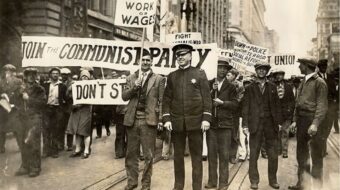
In 1980, the richest 1 percent paid 34.5 percent of their income to taxes. By 2008, the richest 1 percent paid 23.3 percent of their income to taxes. This information came from a report of the Tax Foundation. It was data like this plus the documentation that drew me to The Price Of Civilization by Jeffrey Sachs. Sachs, who presently teaches at Columbia University, calls himself a clinical economist. With economic and financial problems dominating the electoral scene, this book is an important source. It is strong on data, although it is weak in analysis and even weaker in offering viable solutions.
Given the lies about Social Security and Medicare being cast about by Republican candidates for president, check this out. In 1959, the elderly poverty rate was at 35.2 percent. Then came the passage of the Social Security Amendments of 1965. These included both Medicare and Medicaid. By 1969, the elderly poverty rate fell to 25.3 percent, by 1979 to 15.2 percent, by 1989 to 11.4 percent. By 2008, the elderly poverty rate dropped to 9.7 percent. These data from the U.S. Census Bureau are invaluable to debunk the lies spread by Newt Gingrich. His goal of destroying Social Security stretches back to the infamous Contract For America of the mid-1990s. It became better known as the Contract On America.
Sachs is particularly good at showing where productive value from work is going. He states that CEOs are cashing in like never before. At the beginning of the 1970s, the average top-100 CEO was making off with 40 times the average worker’s pay. By 2000, the average top-100 CEO was ripping off 1,000 times the average worker’s pay. During the same period the median take-home pay of male full-time workers, adjusted for inflation, has stagnated.
In fact, the attacks on Social Security and Medicare, the plummeting of tax rates for the very rich, soaring profits, and the outlandish pay for top CEOs are all evidence of a rapacious, unrelenting class war by the rich. Attacks on President Obama for making class warfare are hollow at best. Class warfare has been part and parcel of capitalism from the get-go. The attempts to label our first black president as a socialist and the “food stamp president” smack of anticommunism and racism, the twin divisive ideologies of that same capitalist class.
Jeffrey Sachs’s research and writing can be a real working class weapon in this crucial election year. It comes with a number of provisos. While useful information pours out of its pages, its analysis is faulty and its solutions, at times, are down right misleading.
The author tends to attribute laws passed to presidents, particularly Johnson and Kennedy. For example, the benefits to the elderly from Social Security and Medicare are attributed to Lyndon Johnson with no mention of the civil rights movement and labor movement at the grass roots. Without these movements, there would have been no or a limited “war on poverty.” The author had an excellent opportunity to show how unity benefits all citizens. It’s not there.
The Price of Civilization makes a case for the root of the economic crisis being one of a lack of civic virtue among the elite. This focus places the structural crisis, including financialization, and the cyclical crisis of capitalism a distant second. This moral crisis emphasis leads the author to plead with the rich to please pay more taxes. A political novice would recognize the futility in this approach.
Sachs states that the environment is the second most decisive issue facing our people. (He places education first, geopolitics third and managing diversity fourth.) Yet, at the same time, he attacks greens for opposing nuclear power. This flies in the face of past and recent nuclear meltdowns in the Soviet Union and Japan respectively and the close call at Three Mile Island in the USA. Missing also is a call for green jobs that are so badly needed and would unite the environmental and labor movements.
The author particularly misfires when it comes to political focus. After exposing the class warfare made by the rich on the working class, where does Sachs aim his main fire? Unfortunately, it is at President Obama. The author takes particular aim at the various stimulus bills which quite possibly averted a much more dire economic downturn. Nor does the author see the danger in strengthening the extreme right with such attacks.
Sachs needs to be more analytical when it comes to history. After World War I, Germany and Italy were wracked with failing financial Institutions, high unemployment and parliaments incapable of solving their countries’ economic woes. Their wealthy classes wanted government subsidies flowing to them instead of to the laboring classes. They wanted tax exemptions. Their countries got fascism and the world got World War II.
While the author continuously points the reader in a healthy direction, like tax the rich, agency is almost completely missing. It isn’t until the very last chapter that he singles out the millennial generation as a force for change. But while young people can play an important role, vast movement experience shows that left to their own devices, youth will gravitate to spontaneity and can even be pulled in reactionary directions. Organized labor combined with women, people of color and youth would have both the power and direction that is needed in this election year and beyond.
Book information:
The Price of Civilization: Reawakening American Virtue and Prosperity
By Jeffrey Sachs
2011, Random House, 336 pages, hardcover, $27.00
Art Perlo contributed to this article.










